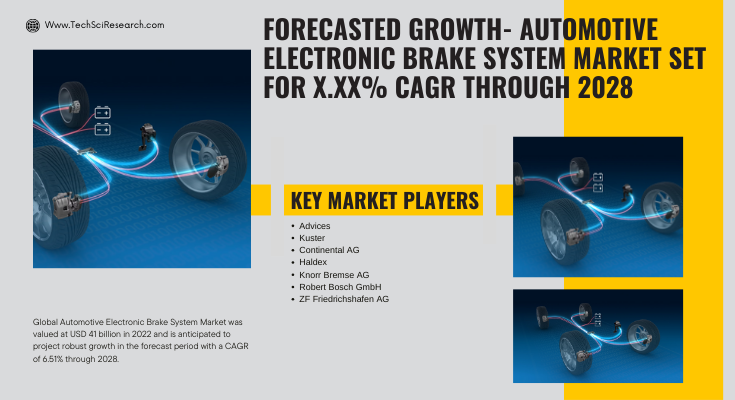According to TechSci Research report, “Global Automotive Electronic Brake System Market – Industry Size, Share, Trends, Competition Forecast & Opportunities, 2028”, the Global Automotive Electronic Brake System Market stood at USD 41 billion in 2022 and is anticipated to grow with a CAGR of 6.51% in the forecast period, 2024-2028. By using an electronic control unit, an automotive electronic brake system makes driving and total braking possible.
An effective braking mechanism is provided by an automotive electronic brake system, which is made up of various parts including actuators, control units, sensors, and others. The car electronic brake system is becoming increasingly popular among owners of OEM and aftermarket brands due to its capacity to deliver effective brake management along with high-end automation.
Given that demand for premium, safety vehicles is at an all-time high on all continents, the market for automotive electronic brake systems appears to have an astounding growth outlook in the future.
Browse over market data Figures spread through XX Pages and an in-depth TOC on “Global Automotive Electronic Brake System Market.” @ https://www.techsciresearch.com/report/automotive-electronic-brake-system-market/22711.html
The Global Automotive Electronic Brake System (EBS) market represents a pivotal evolution in the automotive industry, revolutionizing the way vehicles control their braking systems. This market encompasses a wide range of technologies, components, and systems that replace or augment traditional hydraulic braking mechanisms with electronic control and automation.
The adoption of EBS has become increasingly prominent due to its contributions to safety, performance, and the overall driving experience. One of the primary drivers of the Global Automotive Electronic Brake System market is the unwavering commitment to vehicle safety. Safety has always been a paramount concern for the automotive industry, and electronic brake systems play a pivotal role in enhancing vehicle safety standards. Unlike traditional hydraulic brakes, electronic brake systems offer advanced features such as anti-lock braking systems (ABS), electronic stability control (ESC), and brake assist systems. These features provide improved control and prevent wheel lockup during braking, reducing the risk of accidents in various driving conditions.
Additionally, EBS enables the integration of advanced driver-assistance systems (ADAS) such as collision avoidance and autonomous emergency braking, contributing to a significant reduction in accidents and fatalities. The market is also driven by the growing demand for enhanced performance and efficiency. Electronic brake systems offer precise and rapid control of braking forces, resulting in shorter stopping distances and improved vehicle stability during emergency maneuvers.
This leads to enhanced vehicle performance and better driving experiences. Moreover, EBS facilitates regenerative braking in hybrid and electric vehicles, where kinetic energy is converted into electrical energy and stored in batteries. This technology boosts energy efficiency and contributes to extended electric range, reducing the overall energy consumption of vehicles.
Furthermore, the market is influenced by the industry’s shift towards connectivity and autonomous driving. Electronic brake systems play a crucial role in supporting advanced connectivity features by enabling communication between the vehicle and external systems. They are integral to autonomous vehicles as they provide the precise and adaptive control required for automated driving functions. The development of electronic brake-by-wire systems, which replace traditional mechanical linkages with electronic control, is pivotal in achieving the flexibility and redundancy necessary for autonomous driving.
The Global Automotive Electronic Brake System market is further propelled by the increasing trend towards electrification and the adoption of electric vehicles (EVs). Electronic brake systems in EVs provide the necessary control and precision for regenerative braking, a process that converts kinetic energy into electrical energy during deceleration. This regenerative braking not only improves energy efficiency but also extends the driving range of EVs. As the demand for EVs continues to grow, the market for electronic brake systems will expand accordingly, reinforcing their significance in the automotive industry.
Moreover, the adoption of advanced materials and manufacturing processes is driving innovation in the market. The development of lightweight materials and the utilization of advanced production techniques allow for the creation of compact and efficient electronic brake system components. Additionally, the integration of electronic brake systems with other vehicle systems, such as advanced sensor technologies and control algorithms, enables more responsive and adaptable braking performance, contributing to improved safety and performance.
In addition to these drivers, regulatory requirements and consumer preferences play a significant role in shaping the Global Automotive Electronic Brake System market. Governments around the world impose strict safety standards and regulations, pushing automakers to incorporate advanced electronic brake systems to comply with these requirements. Consumer demand for safer and more technologically advanced vehicles further propels the adoption of electronic brake systems. Automakers are keen to meet these demands by integrating EBS into their vehicle designs.
Despite the promising prospects, the market faces several challenges. One primary challenge is the complexity of electronic brake system components and their integration into vehicles. EBS systems consist of various sensors, electronic control units (ECUs), and actuators, which require advanced engineering and integration efforts. Additionally, the extensive use of electronic components in brake systems makes them susceptible to cybersecurity threats. Ensuring the security of electronic brake systems from potential hacking or tampering is a critical concern. Another challenge is the need for industry standardization and interoperability. As the market continues to evolve, different automakers and suppliers may use proprietary technology or communication protocols, leading to compatibility issues. Industry-wide standardization efforts are essential to ensure seamless integration and interoperability between EBS components and systems.
Moreover, the cost of EBS components and systems can be a deterrent, especially for consumers and automakers in emerging markets. Electronic brake systems are typically more expensive than traditional hydraulic systems, which can impact the affordability and accessibility of vehicles. Manufacturers need to find ways to reduce the cost of electronic brake systems to make them more widely available.
Major companies operating in the Global Automotive Electronic Brake System Market are:
- Advices
- Kuster
- Continental AG
- Haldex
- Knorr Bremse AG
- Robert Bosch GmbH
- ZF Friedrichshafen AG
- Halla Mando
- Akebono Brake Industry Co., Ltd
- Brembo.
Download Free Sample Report @ https://www.techsciresearch.com/sample-report.aspx?cid=22711
Customers can also request for 10% free customization on this report.
“The Global Automotive Electronic Brake System (EBS) market is at the forefront of automotive safety and performance innovation. Driven by a steadfast commitment to safety, EBS technologies such as anti-lock braking systems (ABS) and electronic stability control (ESC) have significantly reduced accidents and fatalities. Moreover, EBS enhances performance by enabling precise control, shorter stopping distances, and regenerative braking in electric vehicles. It plays a pivotal role in the development of connected and autonomous vehicles, providing the precise control required for advanced driver-assistance systems and automated driving functions. However, challenges include system complexity, cybersecurity concerns, standardization efforts, and cost considerations. Nevertheless, the Global Automotive Electronic Brake System market remains essential in shaping the future of automotive safety and technology.” said Mr. Karan Chechi, Research Director with TechSci Research, a research-based management consulting firm.
“Automotive Electronic Brake System Market – Global Industry Size, Share, Trends, Opportunity, and Forecast, Segmented By Vehicle Type (Passenger Cars, Light Commercial Vehicles, Medium & Heavy Commercial Vehicles), By Components Type (Sensors, Actuators, Control Units, Others), By Technology Type (Brake Assistance, Autonomous Emergency Braking, Electronic Stability Control, Anti-Lock Braking System), By Region, Competition, 2018-2028”, has evaluated the future growth potential of Global Automotive Electronic Brake System Market and provides statistics & information on market size, structure and future market growth. The report intends to provide cutting-edge market intelligence and help decision makers take sound investment decisions. Besides, the report also identifies and analyzes the emerging trends along with essential drivers, challenges, and opportunities in the Global Automotive Magnesium Alloy Market.
You may also read:
Automotive Plastic Fasteners Market – Current Analysis and Forecast [2028]
Competitive Landscape and Innovation in North America Automotive Heat Shield Market
Automotive Vehicle-To-Everything Market [ Latest] Report by Analysis, Share, Leaders
E-Commerce Automotive AfterMarket Industry [2028]- Exploring Robust Growth & Forecast
Rising Demand and Growth Trends– North America Automotive Air Filters Market
Table of Content-Automotive Electronic Brake System Market
- Introduction
1.1. Product Overview
1.2. Key Highlights of the Report
1.3. Market Coverage
1.4. Market Segments Covered
1.5. Research Tenure Considered
- Research Methodology
2.1. Objective of the Study
2.2. Baseline Methodology
2.3. Key Industry Partners
2.4. Major Association and Secondary Sources
2.5. Forecasting Methodology
2.6. Data Triangulation & Validation
2.7. Assumptions and Limitations
- Executive Summary
3.1. Market Overview
3.2. Market Forecast
3.3. Key Regions
3.4. Key Segments
- Impact of COVID-19 on Global Automotive Electronic Brake System Market
- Global Automotive Electronic Brake System Market Outlook
5.1. Market Size & Forecast
5.1.1. By Value
5.2. Market Share & Forecast
5.2.1. By Vehicle Type Market Share Analysis (Passenger Cars, Light Commercial Vehicles, Medium & Heavy Commercial Vehicles)
5.2.2. By Component Type Market Share Analysis (Sensors, Actuators, Control Units, Others)
5.2.3. By Technology Type Market Share Analysis (Brake Assistance, Autonomous Emergency Braking, Electronic Stability Control, Anti-Lock Braking System)
5.2.4. By Regional Market Share Analysis
5.2.4.1. Asia-Pacific Market Share Analysis
5.2.4.2. Europe & CIS Market Share Analysis
5.2.4.3. North America Market Share Analysis
5.2.4.4. South America Market Share Analysis
5.2.4.5. Middle East & Africa Market Share Analysis
5.2.5. By Company Market Share Analysis (Top 5 Companies, Others – By Value, 2022)
5.3. Global Automotive Electronic Brake System Market Mapping & Opportunity Assessment
5.3.1. By Vehicle Type Market Mapping & Opportunity Assessment
5.3.2. By Component Type Market Mapping & Opportunity Assessment
5.3.3. By Technology Type Market Mapping & Opportunity Assessment
5.3.4. By Regional Market Mapping & Opportunity Assessment
- Asia-Pacific Automotive Electronic Brake System Market Outlook
6.1. Market Size & Forecast
6.1.1. By Value
6.2. Market Share & Forecast
6.2.1. By Vehicle Type Market Share Analysis
6.2.2. By Component Type Market Share Analysis
6.2.3. By Technology Type Market Share Analysis
6.2.4. By Country Market Share Analysis
6.2.4.1. China Market Share Analysis
6.2.4.2. India Market Share Analysis
6.2.4.3. Japan Market Share Analysis
6.2.4.4. Indonesia Market Share Analysis
6.2.4.5. Thailand Market Share Analysis
6.2.4.6. South Korea Market Share Analysis
6.2.4.7. Australia Market Share Analysis
6.2.4.8. Rest of Asia-Pacific Market Share Analysis




